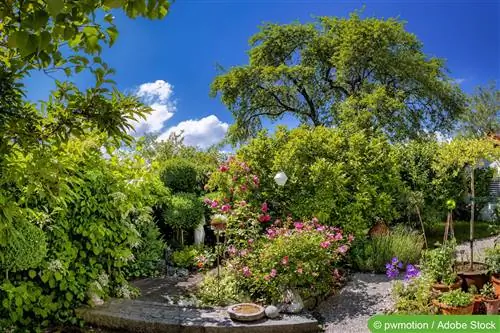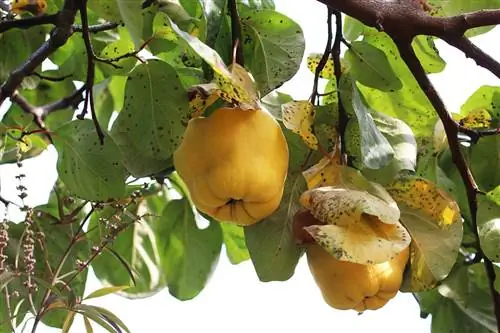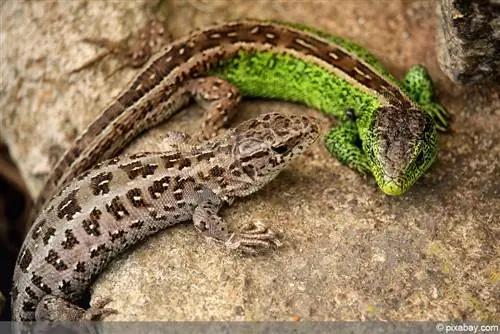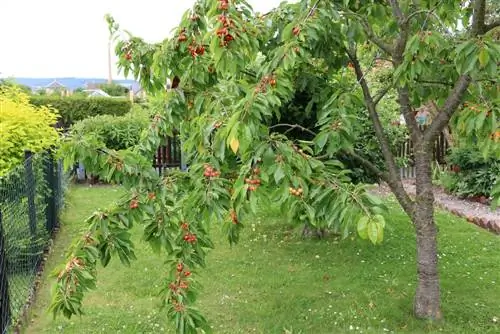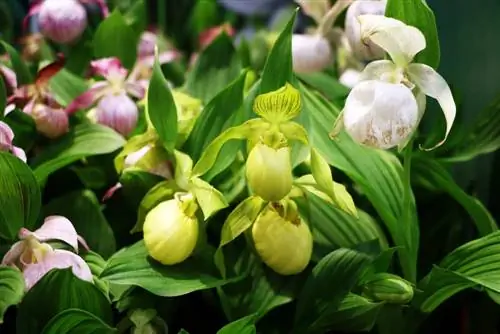- Author admin [email protected].
- Public 2023-12-17 03:39.
- Last modified 2025-06-01 06:48.
Deciduous trees not only shape the face of the garden, but also offer space to set up shady spots.
Popular deciduous trees for the garden
The witch hazel, which opens its flowers in winter, is particularly popular. Forsythias are also very common and their yellow flowers in spring heighten the anticipation of summer. Shortly after the forsythia blooms, you can see blooming magnolias everywhere, which provide soothing shade in summer. In terms of color, magnolias are at their most beautiful in autumn. Maples, the sweetgum tree and Pfaffenhütchen are also particularly beautiful to look at in autumn.
However, not all hardwoods are subject to seasonal fluctuations, as there are also many plants that are green all year round, such as holly and cherry laurel. The gorse is also very popular and retains its leaves until spring.
There are also deciduous trees that are a feast for the eyes, especially with their flowers, while others have beautiful leaves or are impressive with their growth habit. You also have to take into account the scent of the wood, which couldn't be more different. Hardwoods are popular because they are very durable and form the face of the garden more than any other plants. Therefore, when planning a garden, it is important to place the hardwoods in the right places:
- You can use it as a solitary tree or as a ground cover.
- Deciduous trees are often found as hedges or as underplanting.
Due to the wide range of native deciduous trees on offer, you can give free rein to your design ideas. However, you should be familiar with the soil and climate conditions at the location, because the deciduous trees sometimes have their own requirements. Because this is the only way to have friends in your garden for many years to come.
Most common representatives of native deciduous trees
The most common deciduous trees found in German gardens are:
- the black or red alder,
- the sycamore maple,
- the native rock pear,
- the boxwood,
- the hazelnut tree,
- the copper beech
- and the common ash tree
- and the common ivy.
Very often you can also find garden holly, quaking aspen and bird cherry. All deciduous trees can be found in the garden department of a well-stocked hardware store or in a garden center. In the latter you get expert advice straight away, which can be very valuable. You can also order a lot of deciduous trees online. Here too, the information content is very diverse and valuable.
Tree or shrub?
Above we sometimes talked about deciduous trees or hardwoods, then again about deciduous trees, and then names appear that are more familiar from the decorative individual shrubs or hedge plants that stand alone in the garden. So what is a tree and what is a deciduous tree, and what is the difference to the plants that are actually commonly called shrubs?
Well, this very definition is so complicated that all of the above-related terms have their place. The difference between tree and shrub is by no means sharp, but is made by biologists “according to evidence,” so to speak:
- The main difference is that a tree grows primarily in the crown area, whereas a shrub always produces new wood from the rootstock.
- Accordingly, we refer to woody plants as “trees” that grow quite tall, only begin to branch at a certain height and have their foliage primarily in the treetop.
But this rule is not completely adhered to: the poplar grows, for example. B. typically from the ground, so it is actually a “poplar bush”. The (rather arbitrary) boundary between tree and bush is set between 5 and 10 meters high (but hazel “bushes” often grow taller than cherry “trees” and some trees really don’t grow very tall at the tree line in the mountains). Quite a few hardwoods can do both; they grow as a tree just as often as a shrub, e.g. E.g. elderberry, juniper and the already mentioned hazelnut. Humans can not only “uproot trees” and “plant trees”, but also “shape trees” by forcing the plant to form a trunk through cutting measures.
- However, all trees are trees, because a plant is always referred to as a “woody plant” when its branches become woody, i.e. the biopolymer lignin is stored in its cell walls and thus becomes stronger.
- It is also characteristic of hardwoods that they live for several to many years (apart from trees and bushes, there is only one perennial type of plant, the perennials).
- Deciduous trees are the woody plants that form leaves and not needles, in contrast to conifers (the needles are actually just leaves, “needle leaves”).
Native deciduous trees - ecologically the best choice
Native trees definitely belong in our gardens, even if for a time their aesthetics seemed to fade behind the modern appeal of exotic imports and their ecological value was not considered as important. Today we can appreciate the once familiar trees and bushes again; a plant that feels really comfortable in its habitat looks better in the long term than a sterile exotic plant that withers away if it doesn't receive a lot of extra care that he needs in a foreign climate.
Their ecological importance has even increased: In times when many gardens only consist of faceless hybrids and more and more people live in an environment in which the surrounding greenery is subject to human design, the long-established plants are for the wildlife that surrounds us is vital. If we don't want to be the only species on this earth at some point, we have to offer our fellow creatures a basis of life, protection, breeding places and sources of food, and we do that when we choose woody plants that are originally native to a region.
It is true that some “smart birds” dare to approach non-native woody species, but other animals are more “shy”, and if we want to maintain the existing diversity, we need native trees and shrubs in the garden, everyone individual forms a whole small ecosystem.
Native deciduous trees at a glance
And it's not like there isn't enough choice of native deciduous trees. Here is a brief overview of what belongs here and can become a deciduous tree (many of which can also become a shrub or hedge): maple, acacia, sycamore, sycamore, birch, beech, copper beech, mountain ash, oak, serviceberry, alder, ash, aspen (Aspen), sweet chestnut, field elm, white elm, gray alder, green alder, hornbeam, chestnut, cork oak, mulberry, downy birch, whitebeam, palm maple, plane tree, plum oak, black locust, European beech, red oak, sand birch, umbrella acacia, black alder, blackwood acacia, silver acacia, Norway maple, common oak, bird cherry, sessile oak, elm, rowan, walnut, willow, wild cherry, oak, sugar maple, and then there are our many fruit trees.
If we move towards deciduous trees, which are generally intended to grow as shrubs, there is still a lot to choose from:
- Barberry, bladderwort, blackberry, boxwood,
- rotten tree, serviceberry, lilac,
- Common Snowball, Laburnum,
- Dogwood, hazelnut, honeysuckle, raspberries, elderberry,
- currants, buckthorn, cornelian cherry, medlar,
- Sea buckthorn, spindle bush, holly and hawthorn.
Again, only a few have been listed here, there are many other native hardwoods, definitely the right ones for every garden design. By the way, you should be careful when purchasing the forsythia mentioned above if you really want to get a native tree: There is a European forsythia (but it is native to southeastern Europe and loves the corresponding warmth), but the forsythia usually sold in garden centers is a hybrid two Asian species that are ecologically rather critical because our insects and birds usually avoid them.
In general, the distinction is not always easy, in the first section above some species were mentioned that are often seen in gardens and are already so familiar to us that they are often mistaken for native plants. If you want to be sure about the ecological benefits of a deciduous tree, you can either buy a familiar variety or find out how long a tree has been naturalized in our country and how many insects etc. it provides food for (but you would then have to go to a specialist company go shopping with well-trained staff).

